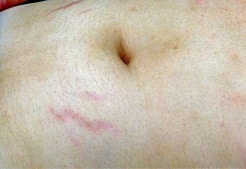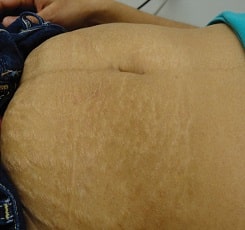Don’t forget to read Tattoos and Pregnancy.
Definition and explanation why:

Stretch marks, which are medically known as striae gravidarum, occur in about 63% of pregnant women. They are bands of skin that appear stretched, often red or purple (striae rubra), which mainly affect the abdomen, breasts, buttocks and thighs. Stretch marks usually appear during the sixth or seventh month of pregnancy, and sometimes earlier. They will become white (striae alba) over time.
Many factors can cause stretch marks, including hormonal changes, genetic predisposition, and the physical stretching of the skin.
The literature highlights risk factors: the mother’s young age, family history, pre-pregnancy and pre-childbirth weight, and the baby’s weight at birth.

The central hypothesis is that the hormonal environment during pregnancy makes the skin more susceptible to being overly stretched. This stretching breaks down the structure of the skin’s tissue, the skin’s collagen due to the stretching effect, and leads to the appearance of stretching, so that’s why we call them stretch marks.
Since the hormonal and genetic aspect is very present, it is scientifically challenging to prevent stretch marks, because we can’t control heredity and physiological changes during pregnancy.
Recommendations for stretch marks during pregnancy
- During a healthy pregnancy, continue to be physically active and gain a healthy weight set by the doctor monitoring their pregnancy.
- There is little evidence concerning stretch mark prevention. Some studies have shown that daily massages with creams containing Centella Asiatica (trofolastin cream) can have a slight beneficial effect.
- Hydrating your skin daily can’t hurt, but there is no scientific evidence about the results. Even “anti-stretch mark” creams can’t perform miracles. You are born with the skin you have!
Recommendations for stretch marks after childbirth:

- To reduce redness, vascular laser procedures can be tried. But over time, the stretch mark will become white if not treated.
- Retinoid-based creams, if used daily on the abdomen or elsewhere for 3-7 months, may show an improvement of about 20% according to some studies.
- There are very few treatments available. Laser treatments done by professionals have shown improvements of 50-70% according to some studies, but they are expensive.
As you can see, many skin changes occur during pregnancy. I hope that this helps you understand that you have little control over it, and I hope that you will accept it over time.
Marie Fortier
The Baby Expert
Updated article : March, 2025.


